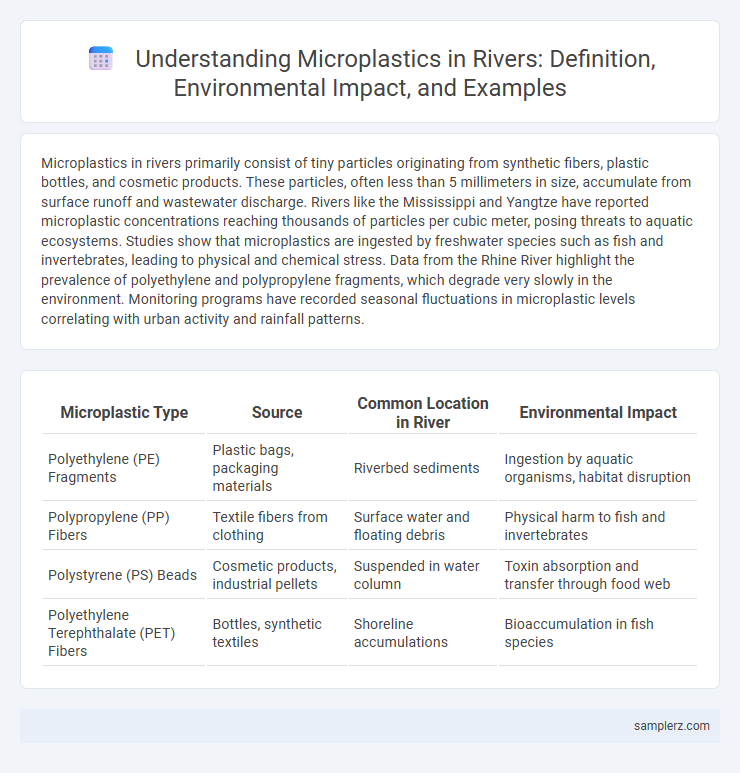Microplastics in rivers primarily consist of tiny particles originating from synthetic fibers, plastic bottles, and cosmetic products. These particles, often less than 5 millimeters in size, accumulate from surface runoff and wastewater discharge. Rivers like the Mississippi and Yangtze have reported microplastic concentrations reaching thousands of particles per cubic meter, posing threats to aquatic ecosystems. Studies show that microplastics are ingested by freshwater species such as fish and invertebrates, leading to physical and chemical stress. Data from the Rhine River highlight the prevalence of polyethylene and polypropylene fragments, which degrade very slowly in the environment. Monitoring programs have recorded seasonal fluctuations in microplastic levels correlating with urban activity and rainfall patterns.
Table of Comparison
| Microplastic Type | Source | Common Location in River | Environmental Impact |
|---|---|---|---|
| Polyethylene (PE) Fragments | Plastic bags, packaging materials | Riverbed sediments | Ingestion by aquatic organisms, habitat disruption |
| Polypropylene (PP) Fibers | Textile fibers from clothing | Surface water and floating debris | Physical harm to fish and invertebrates |
| Polystyrene (PS) Beads | Cosmetic products, industrial pellets | Suspended in water column | Toxin absorption and transfer through food web |
| Polyethylene Terephthalate (PET) Fibers | Bottles, synthetic textiles | Shoreline accumulations | Bioaccumulation in fish species |
Common Sources of Microplastics Found in Rivers
Common sources of microplastics found in rivers include synthetic fibers from laundry wastewater, tire wear particles from roads, and fragmented plastic packaging debris. These microplastics enter aquatic ecosystems through urban runoff, wastewater treatment plant effluents, and improper disposal of plastic waste. River sediments and aquatic organisms often contain high concentrations of these microplastic particles, highlighting widespread contamination.
Industrial Waste and Microplastic Pollution
Industrial waste often contains microplastics from synthetic fibers, plastic pellets, and fragmented packaging materials, which enter rivers through untreated effluents. These microplastic particles accumulate in aquatic ecosystems, posing toxic risks to wildlife and disrupting natural processes. Continuous monitoring reveals that industrial discharge is a significant source of microplastic pollution in major river systems worldwide.
Microbeads from Personal Care Products in Waterways
Microbeads from personal care products such as exfoliating scrubs and toothpaste have been detected in numerous river systems worldwide, contributing significantly to microplastic pollution. These tiny plastic particles are resistant to degradation and easily bypass wastewater treatment plants, accumulating in freshwater habitats and posing threats to aquatic life through ingestion and chemical contamination. Studies show rivers like the Thames in the UK and the Mississippi in the USA exhibit elevated microbead concentrations, underscoring the urgent need for regulatory measures targeting microplastic release from consumer products.
Synthetic Microfibers from Laundry Effluent
Synthetic microfibers from laundry effluent constitute a significant source of microplastic pollution in rivers, as they shed from fabrics during washing cycles and enter waterways via wastewater systems. Studies show that a single laundry load can release over 700,000 microfibers, which are smaller than 5 millimeters and can persist in aquatic ecosystems, threatening wildlife and accumulating in the food chain. Advanced filtration technologies and improved wastewater treatment methods are critical to reducing the discharge of these synthetic microfibers into river environments.
Plastic Fragmentation in Freshwater Ecosystems
Microplastic pollution in freshwater ecosystems primarily results from plastic fragmentation, where larger plastic debris breaks down into tiny particles due to environmental factors like UV radiation and mechanical abrasion. Rivers such as the Mississippi and Yangtze exhibit high concentrations of microplastic fragments, significantly impacting aquatic organisms through ingestion and habitat contamination. These microplastics contribute to the disruption of freshwater biodiversity and pose challenges for water quality management.
Microplastics from Urban Runoff and Stormwater
Microplastics from urban runoff and stormwater are a significant source of river pollution, originating from synthetic fibers, tire wear particles, and fragmented plastic debris. These tiny particles enter waterways through drainage systems during rainfall, accumulating in sediments and harming aquatic ecosystems. Studies show that urban areas contribute up to 80% of microplastic pollution in nearby rivers, emphasizing the need for improved stormwater management and filtration technologies.
Agricultural Practices Contributing to River Microplastics
Agricultural practices contribute significantly to microplastic pollution in rivers through the use of plastic mulch films, pesticide containers, and irrigation tubing that degrade into small plastic particles. These microplastics enter waterways during runoff and soil erosion, especially after heavy rainfall or flooding events. Studies show that rivers adjacent to intensive farming areas exhibit higher concentrations of polyethylene and polypropylene microplastics linked to agricultural activities.
Impact of Recreational Activities on Microplastic Levels
Recreational activities such as boating, fishing, and picnicking significantly increase microplastic contamination in rivers by introducing synthetic fibers from clothing and plastic waste like fishing lines and packaging. Studies indicate that areas with high recreational use exhibit microplastic concentrations up to 30% higher than less frequented sites. These microplastics disrupt aquatic ecosystems by harming fish and invertebrates, which ingest particles leading to bioaccumulation and toxicity.
Microplastics from Tire Wear and Road Dust
Microplastics from tire wear and road dust significantly contribute to river pollution, releasing synthetic rubber particles and fine particulate matter into aquatic ecosystems. These microplastic particles accumulate in river sediments and pose toxic risks to freshwater organisms, disrupting food webs and biodiversity. Monitoring tire wear debris levels in urban river basins is critical to understanding their environmental impact and guiding pollution mitigation strategies.
Case Studies of Microplastic Contamination in Major Rivers
Microplastic contamination in the Yangtze River has been extensively documented, revealing concentrations exceeding 100,000 particles per cubic meter in some urban areas. Studies of the Ganges River show microplastics primarily originating from household waste and textile fibers, severely impacting aquatic biodiversity. The Mississippi River demonstrates significant microplastic pollution linked to agricultural runoff and industrial discharge, highlighting the need for targeted mitigation strategies.

example of microplastic in river Infographic
 samplerz.com
samplerz.com